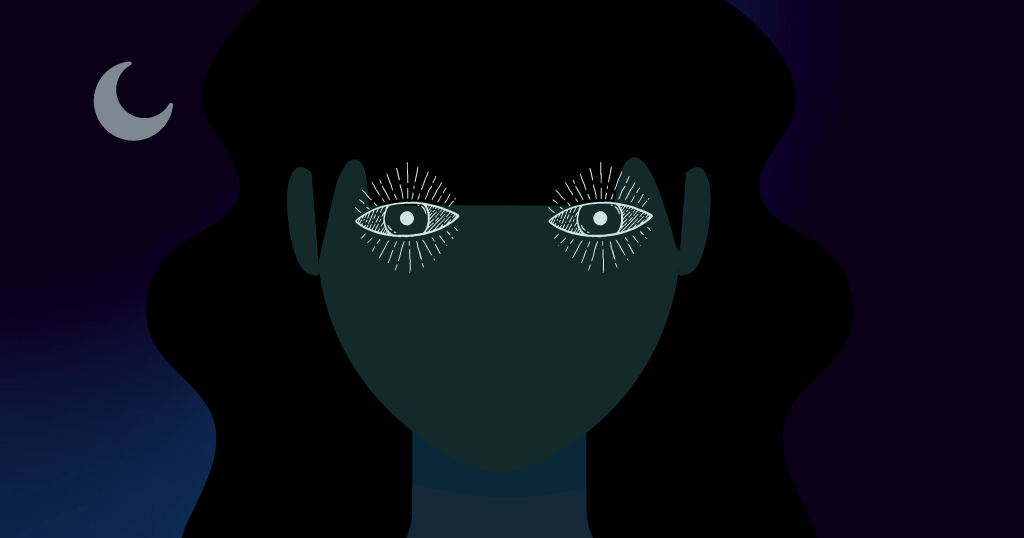Three times in my life I’ve had episodes of severe insomnia, with my sleep reducing steadily until I was sleeping one hour a night or less. Two episodes lasted for years, one for several months. The episodes led to a super-shitty quality of life, cognition, and coping skills. It took me years to associate the sleep issues with water-damaged buildings.
The first and third episodes were caused by moldy homes, which caused huge amounts of inflammation and screwed up my already lousy breathing. The second episode was caused by a prescription drug.
First episode: the 1928 mansion
The first episode started some time after I moved into a pre-war, falling-down, badly-maintained Tudor mansion, and lasted about three years.
The basement had been flooded for months before anyone noticed, and ruined piles and piles of books, magazines, and personal papers (not mine). The ceiling of the bathroom closest to my bedroom turned blackish-green with mold if I didn’t clean it every week. The wiring was so decrepit that a local electrician told us he could not legally work on it.
I had been sleeping three hours a night when I started a prescription for Zoloft to treat depression. The sleep immediately went down to two hours. About a year later, I moved to a better-maintained house built in 1910, but had no improvement. Three months later I moved again.
Recovery #1, then relapse: the 1995 townhouse
According to detailed logs I took at the time and forgot about for years, shortly after I moved to a newly-built, well-maintained, non-water-damaged townhouse, my sleep improved to seven hours a night. I had also left most of my possessions behind: I had to acquire a new wardrobe after gaining 20 pounds, and the majority of my stuff was put in storage.
(Within a few weeks of moving, I began tapering off the Zoloft. I don’t remember what effects that caused.)
Several months after that, the insomnia resumed. For years afterward, the episodes merged together as one episode. In hindsight, it was two separate episodes, with two different causes, very close together.
The Diflucan disaster
At the time I was suffering brain fog, a whole lot of food intolerances, and lousy digestion. I had asked my mainstream doctor about the prescription anti-fungal Diflucan, a common treatment for candida infections, which at the time was a big thing in complementary / alternative medicine as a potential cause for just about everything. He’d given me a prescription.
Within a week of starting it, my sleep went down to 40 minutes a night, in two twenty-minute phases. That lasted four months. (Three months into it, to my eternal astonishment, I managed to land the best job I ever had.)
Recovery #2
Finally, getting no help or even one lousy shit from any medical practitioner, anywhere, I started drinking a GALLON of distilled water every day, on the theory I had poisoned my liver. After five days, my sleep went up to three hours, and then up to five shortly after that. (Why I chose distilled water, I do not remember.)
This marked the end of my willingness to rely on prescription drugs. Around this time I also got serious about my nutritional therapy self-experiments, which are the focus of the majority of my early posts.
Third episode: the 1929 apartment building
Two years? or so after that I moved into a pre-war, inexpensive, poorly-maintained apartment building. The insomnia slowly worsened until 2015, when I was sleeping an hour a night.
The living room’s bay window frame was warped and swollen, my bedroom closet was repeatedly damaged by roof leaks and became unusable, and water streamed down one wall each of my bedroom and the living room whenever it rained heavily.
Two promising interludes
At one point, in around 2010?, recovering from surgery at my parent’s newly-built house for a week, I slept pretty well. Once I returned to my apartment, the sleep returned to its previous hellishness. I assumed the improvement was due to my walking outside every night through the empty fields around their home. My own neighborhood was not safe enough to do that.
About a year before I left the 1929 building, I had some success when I began using air filters in every room, vacuuming obsessively, and taking bile acids several times a day. That gave me three hours of sleep a night, but only for one week.
Finding the mold connection
Before the last episode of insomnia started, a fatigue had set in that eventually led me to start investigating chronic fatigue, which I write about here. I eventually joined an online support group. One day they posted about a front-page article in the New York Times on the reclassification of chronic fatigue syndrome in the U.S. The very first comment to that article was by a woman who’d found that mold avoidance resolved her chronic fatigue.
A mad round of research led me to a specialist in Chicago who treated an umbrella of inflammation symptoms called Chronic Inflammatory Response Syndrome. Mold-poisoned people were the majority of those patients. Then I found another place to live that was new, well-maintained, and obsessively cleaned.
Recovery #3: the 2001 townhouse
Within five days of moving in to the 2001 townhouse, I was sleeping five hours a night again. I also followed the protocol I found in Dr. Ritchie Shoemaker’s writing on mold poisoning. I ended up doing the following:
- replaced all my clothes with new ones
- sent to the landfill hundreds of books and all my upholstered furniture and bedding
- gave away my handbags, coats, clothes, and shoes
- replaced my drivers license, wallet, and spectacles
- gave away or tossed furniture older than six months
- put newer furniture in storage, as an experiment to see how I reacted to them after several years.
When I first moved in, my 75-year-old mother and I walked around the house looking for signs of water damage. In the attic we found six air vents, which is a happy number in terms of keeping it dry. When we walked around the neighborhood, we noted with interest that the newer homes, even if far larger, had only one or two.
The mold support group
I joined a Facebook group that had originally formed to follow Shoemaker’s protocols, but which had evolved into basically a citizen science group. (You can find a lot of the info they assembled at ParadigmChange.me.) The group’s thousands of users and its moderator began making their own discoveries and theories about what works and what doesn’t regarding mold detox (of your body), remediation (of buildings), detection (in the environment), and avoidance.
The founder and moderator was an engineer by training, quite sharp and articulate, kept a very close eye on the comments, and had a good FAQ and Rules of Conduct. We were all doing our own experiments and learning and reporting.
Basic facts about mold poisoning
- A spore is an individual mold organism / unit. A mycotoxin is the burr-like nano-sized weapon that the spore releases to protect… its territory? Its honor? I dunno. A spore can release up to 300 mycotoxins (don’t quote me on that).
- The vast majority of poisoning is caused by mycotoxins, not spores.
- Mycotoxins pass through your skin. You can also inhale them, obviously.
- The most common mold poisoning culprit is the infamous black mold. Aspergillis is not that dangerous (unless you’re allergic). There are three that are terrifying.
- The main biomarker that the Shoemaker protocol tests to determine poisoning and to gauge recovery is C4a, which measures inflammation.
- To remove mycotoxins from the body, you can bind them with a binder you take orally (there are many) and send them through the digestive tract, or you can sweat them out.
- Different binders seem to be ideal for different molds.
- The Facebook group has tentatively concluded that the binder route, though effective, causes more issues down the road.
- Detoxing the mycotoxins (aka “mold detox”) will not do you much good if you are still in a moldy environment.
- A mycotoxin eliminated via sweat is not the same as a mycotoxin released from a spore. I do not know why. Washing away the sweat, from your body or textiles, will remove them safely. Not so the mycotoxins that never encountered your innards. If you try to wash such a contaminated blanket in your washer, you risk contaminating the washer and everything it ever washes in the future.
- You might react, again, to the mycotoxins in your sweat as you sweat them out.
If I hadn’t been warned beforehand about that last point, I’d have been suicidal on the third day of my sleep restoration, when I was beset with what could be called Restless Body Syndrome. As soon as I got up and changed the clean sheets, I went right back to sleep. For the next 18 months, I had to wash the linens after every second use. Fun!
Further tinkering required
Although this development was a huge relief, the sleep did not improve to more than five hours a night, even after I moved to the desert into an even newer apartment. Eventually I discovered I have to do the following to get seven hours of sleep a night:
- Have audiobooks or lo-fi instrumental music playing all night
- Eat pieces of fruit when I wake several times a night. This has tapered off a lot.
- Never skip meals
- Be vigilant about my sinus health. In order to keep them open, I have to use air filters, replace the HVAC house filters regularly, dust and vacuum a lot, and avoid dairy, corn syrup, and most grains, nuts, and seeds. Super-fun!
Self-experiments
Over the years I investigated and tried hundreds of things to attempt to resolve the insomnia, mostly nutritional therapy, but also: acupuncture, energy medicine, exercise, yoga, sleep clinics, and I don’t remember what else. It’s too depressing to think about.
Resources
- ParadigmChange.me
- Dr. Ritchie Shoemaker’s books
- Survivingmold.com: a website that seems to be a joint project between Shoemaker and one of his patients




